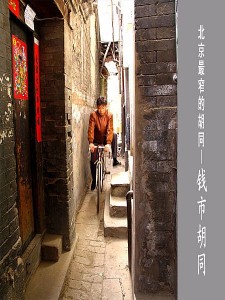Most Featured Hutongs in Beijing
★The Longest Hutong — Dongjiaominxiang (Beijing Legation Quarter)
★The Shortest Hutong — Yichi Dajie
★The Narrowest Hutong — Qianshi Hutong
★The Widest Hutong — Lingjing Hutong
★The Most Zigzag Hutong — Jiuwan Hutong
Dongjiaominxiang is the longest Hutong in Beijing, stretching 1.5 kilometers from west to east. The Hutong had been served as Beijing’s diplomatic center for over 700 years, since the Yuan Dynasty. There are many buildings once used for diplomatic affairs along the street, most of them well preserved. Marco Polo mentioned the lane many times in his masterpieces, making the fame of the lane in Western World. Century-old, western-style buildings conspicuously stand out between newer, imposing government offices.
Yichi Dajie is of course not one chi (the traditional Chinese unit for measure. 1 chi equals to 33.33 cm) long. With a length of more than 20 meters, Yichi Dajie was located near Dashilar, Qianmen Avenue. Now, the Hutong is a section of Yangmeizhu Street. There were 6 old shops along the shortest Hutong in the past. Three of them were inscription shops, the other three were a bar, a smith shop and a barbershop. The narrow lane between north exits of Tongzi Hutong and Yingtao Hutong is Yichi Dajie in nowadays.
Qianshi Hutong, located just to the west of the historical Qianmen main road is a quiet, shabby lane ignored by the traffic around it. It wasn’t always like this. Long before Wangfujing became the swaggering paradise of luxury it is today, Qianshi was the place to go for moneychangers during the Qing Dynasty. All manner of social backgrounds gathered in the lane to barter currency, mainly copper, although the feudal government of the time had restricted tax payments to just silver. Qianshi was the financial center of monetary exchange, and also home to 26 mints producing coin for almost every bank in the city. During the 1900 Boxer Revolution against the Western Powers, a fire swept the area, reducing these banks and mints to ashes. As a result, most of the current housing here dates back to the late Qing period at most. Copper factories were built here, with workshops located in the jewelry market busy turning the raw product into valuables.
In Subway Line 4, there is a station named “Lingjing Hutong” near the commercial area of Xidan. Lingjing in Chinese means “supernatural place”. Today, being close to a prosperous major shopping region, Linjing Hutong has been expanded to over 32 meters wide and is now the widest Hutong in the city. However, its history is a recommendable thing. The original Lingjing goes back to 1417 with the establishment of the Lingji palace or temple in Fujian Province, to commemorate, as well as worship, the Daoist monk Xu Zhizheng and his brother Xu Zhi’e, who were believed to have the power to prevent natural disasters. Later, the Ming Dynasty emperor Zhu Di ordered the construction of another palace in the same style in Beijing, for him to worship there in person. After worship of Daoist Xu declined during the Qing Dynasty, Lingji palace was used for other things and, after years of dilapidation, now no longer exists.
The farther west you walk in the Jiuwan, meaning “Nine Turns” in Chinese, the narrower and quieter the passage gets, shrinking and tightening to less than two meters wide at its narrowest point. Most Hutongs are basically straight, which makes them easier to get in and out of. But Jiuwan Hutong on the south side of the Qianmen Dajie entrance is full of bends and turns. Nine, specifically, making it the most twisted lane in Beijing. But although it is named Jiuwan, or Nine Turns, it actually gets 13 turns. Local residents said that the nine turns are those with 90-degree angles. Unlike other Hutongs, this one doesn’t have much cultural relics. But its uncommon layout and forbidding atmosphere may remotivate Hutong fans who’ve been numbed by the omnipresent “modernized” hutong in the Qianmen area.

